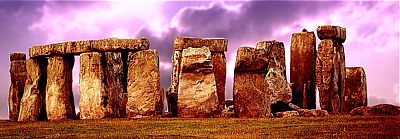Meccas Of The New Age Movement: Stonehenge
Written by: Ginger Red Hawk
Published on: June 16, 2011
Category: Earth Mysteries

Mystery. Power. Stillness.
The sense of being in a place so ancient you can actually feel the spirits whispering to each other. Stonehenge is undoubtedly Britain's greatest National monument symbolizing endurance, history and the strength and determination of those who built it.
Situated on the Salisbury plain, Stonehenge is a destination for visitors from all over the world. Exactly who built Stonehenge or the purpose behind building it is still unknown. We can only guess at its origins.
Who Built Stonehenge?
The question of who built Stonehenge is largely unanswered to date. The Danes, Romans, Saxons, Greeks, Atlanteans, Egyptians, Phoenicians, Celts, King Aurelius Ambrosious, Merlin and even Aliens have been credited with building this great megalith.
The best guess seems to be that the people of the late Neolithic period began the construction of Stonehenge and it was carried forward by the Bearer Folk. Their use of pottery drinking vessels and metal implements and their communal manner of living support this theory.
John Aubrey attributed the Druids with the construction of Stonehenge. According to him, these high priests of the Celts constructed it for sacrificial ceremonies. However, by the time of the Druids, Stonehenge had already been standing for 2000 years as recent discoveries have proven.
The legend of King Arthur also provides another theory. According to Geoffrey of Monmouth it was Merlin who brought the stones to the Salisbury Plain from Ireland. Sometime in the fifth century, there had been a massacre of 300 British noblemen by the treacherous Saxon leader, Hengest. The high king, Aurelius Ambrosius, wanted to create a fitting memorial to the slain men. Merlin suggested an expedition to Ireland for the purpose of transplanting the Giant's Ring stone circle to Britain and hence Stonehenge.
Building Stonehenge
Stonehenge was built in three stages. The first stage happened around 50 centuries ago or 3100 BC when a circle of timbers surrounded by a ditch and bank was constructed. The ditch was probably dug by hand using animal bones and antlers. This is where the mystery begins. Excavators found not only the bones used for digging, they also found 56 holes that were dug to hold wooden posts. They were later named as Aubrey Holes after the 17th century antiquarian, John Aubrey, who found them in 1666.
Then in about 2100 BC Stonehenge was rebuilt. This time the 4 tonne bluestone megaliths from the Prescelli Mountains in Pembroke, South Wales (a distance of about 245 kms) were used. Considering that each stone weighs about 5 tons it must have been quite an amazing feat to transport the stones from Pembroke to Stonehenge. However, the second phase of Stonehenge was stopped before it was completed. No one is entirely sure for what reason.
Then in 2000 BC, work began again. This was the third and final stage and the Stonehenge that was built now turned out to be even bigger and better than the original one. The bluestones were dug up and rearranged and even bigger stones were brought in from Malborough Downs (about 32 kms from Stonehenge). These giant sandstones or Sarsen stones weighed in at about 25 tonnes each. The heaviest of them is said to weigh about 45 tonnes. The Sarsens were positioned in a circle and capped with morticed stone lintels. This is the Stonehenge as we see it today.
About 7 centuries later two mysterious rings of pits were dug around the stones. With the passage of time, the landscape around Stonehenge underwent considerable change and development. In the Neolithic period long barrows and huge earthworks such as the Cursus and Durrington Walls were created. In the Bronze Age hundreds of round barrows were built for the burial of chieftains or leaders, often with grave goods to support them on their journey into the next world. The Avenue, a ceremonial approach to the Stones aligned on the midsummer sunrise, was also built around this period.
Purpose For Building Stonehenge
Just as it is unclear who built Stonehenge and exactly when, the purpose for building it is also ambiguous. A monument of nearly imperishable quality, it was erected at a site of terrestrial energetic power recognized by the people of then. It was most definitely used as a device for astronomical observation used to predict the days in the annual cycle when the earth's energies were most influenced by the movements of celestial bodies. It was also a temple used to celebrate festivals of renewal during the energetically charged days. It was also built with materials chosen very carefully with specific intent. The diorite bluestones brought from 240 miles away show evidence of prior use in another religious structure; the micaceous, green-tinged "altar" stone of unknown origin, and the great sarsen stones all are positioned in a way as to resemble a pre-existing kind of sacred enclosure but, more important, to function as a sort of battery for gathering, storing, and ultimately expressing the earth energies of the site on the festival days. Lastly, perhaps we are given some indication of the power of the site by an old surviving record of an even more ancient folk memory.
The stones are great
And magic power they have
Men that are sick
Fare to that stone
And they wash that stone
And with that water bathe away their sickness
- "Brut" by Layamon, 1200 AD.
